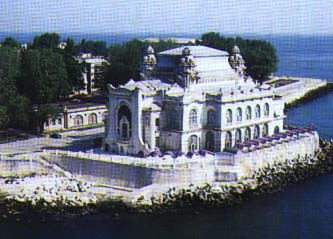Vacation Packages
Constanta vacation packages
constanta Hotels
- Constanta luxury hotels 5*:
- Constanta first class hotels 4*:
- Constanta budget hotels 3*:
- Millenium
- ibis Constanta
- Selection of gut rated hotels in Constanta:

Constanta vacation packages


Constanta: Sights
The Archaeological Museum has a rich collection of Roman statues. Two of them are special: the one of Fortuna Goddess and Pontos God, the two protectors of the town, and the one of Glicon Snake. All of them were discovered in 1962 under the old railway station, after they survived to the invasion of the Avars (the VII-th century A.C.). Also here the tourists can see a Roman mosaic and visit a hall dedicated to Ovidius, a Roman poet, who lived in exile in Tomis between 8 - 17 A.C. After it was destroyed the town was forgotten for 1200 years and only King Carol I gave it a new life at the end of the XIX-th century as a port at the Black Sea and as a resort. Some fine buildings, a casino, hotels were built. Of the Roman town of Tomis there are only a part of the wall of the town and the Butchers Tower (the VI-th century). In an open-air exhibition in the Victory Park there are some columns and amphora's too. Other ruins are in Histria, along the seashore, and in Adamclisi.
The Ottoman domination is marked in Constanta by the Mahmud II's Mosque and the Genovese lighthouse from the XIII-th century is still working nearby the pleasure port. It is pleasant to walk along the seashore or to spend the time at the Casino built in Rococo style. Just in front of the Casino there is the Aquarium which exhibits flora and fauna of the Black Sea.
In Constanta there are also a Dolphinarium with daily shows and a Planetarium.
Constanta - History
2500 years ago, as part of Greek colonization in Pontus Euxinus (Black Sea), was founded Tomis. Tomis sees great prosperity due to the commercial exchange proceeded between Greek colonists and the native Gaeto-Dacians. From the 3rd century BC on rapid paces of development were registered in all fields of activity. Thus, around 300 BC, the Tomis settlement was the battlefield of wars between Lisymah, the Macedonian king and Dromihaites, the Gaeto-Dacian king in the Danubian Plane. Then, under the Roman domination, set up around 29 BC, Tomis made staggering progress. The history of the first years of our era came to the fore due to Publius Ovidius Naso, a Roman poet exiled here between 9 - 17 AC, at Octavian Augustus's orders. During the 2nd century, Tomis became residence of the province taking pride in calling itself, the biggest metropolis of entire Pont. In the middle of the 3rd century and the beginning of the 4th century considerable efforts were made in order to restore the town. It was then when remarkable monuments were built: the Roman building with the mosaic, thermae, residential districts with paved streets, portals and sewers, underground galleries, etc. The wall of the precincts was built in the same period and was subsequently restored several times, the last time in the 6th century AC. Between 4 - 6 century AC the fortress becomes an archiepiscopal headquarter. The inscriptions, the Christian monuments and the four huge basilicas illustrate this historical part. During the 6th and even at the beginning of the 7th century, Tomis was violently attacked by the Slavs and the Avars. In the 9th century the region is reorganized by the Byzantine Empire.
Tomis is recalled by several Byzantine writers under the name of Constantia or Constanta. The town is also found on medieval nautical maps as well as on the Genoa's sailors ones. The economical and cultural role during the Mircea cel Batran's reign is not perceptible, but during the ottoman domination, when called Kostendje, the significance of the town was minor. Town's lethargy continues until the 19th century, when some harbour arrangements were started and the railway Constanta-Cernavoda was laid out, crucial moment for further development of the town. After the Independence War (1877-1878) the town merges out of the ottoman domination, regains its name of Constanta and becomes residence of Constanta region, integrant part of Romania. Harbour arrangements are made as well as constructions of roads, bridges, railways, town planning modernizations. Constanta was seriously affected by the two World Wars, the town being reconstructed each time; after 1945 the rising advance continues and Constanta becames one of the most developed towns in Romania. Nowadays Constanta is the biggest port in Romania, a powerful industrial commercial and tourist centre, a wide gate towards the world.
Tags: Constanta travel guide, vacation rentals, hotels, package holidays, points of interest, car rental, city breaks, weather